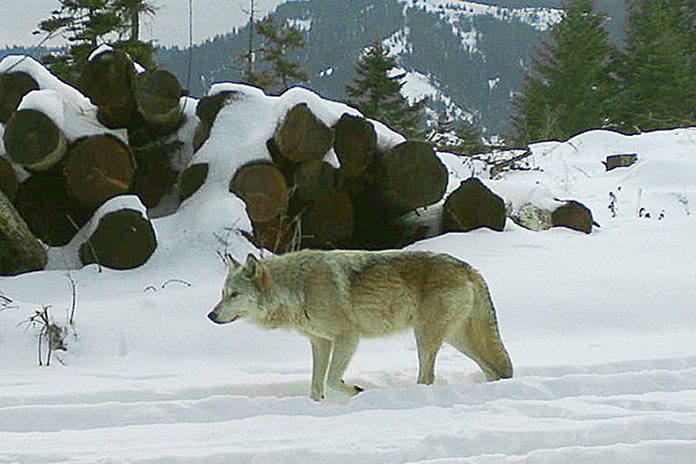
Wildlife biologists with the Oregon Department of Fish & Wildlife counted 124 wolves in Oregon this past winter, an 11 percent increase over the number counted last year.
This count is based on verified wolf evidence (like visual observations, tracks, and remote camera photographs) and is considered the minimum known wolf population, not an estimate of how many wolves are in Oregon.
Twelve wolf packs were documented at the end of 2017. Eleven packs were successful breeding pairs, meaning that at least two adults and two pups survived to the end of the year. This marks a 38 percent increase in breeding pairs from 2016.
“The wolf population continues to grow and expand its range in Oregon,” said Roblyn Brown, ODFW Wolf Coordinator. “This year, we also documented resident wolves in the northern part of Oregon’s Cascade Mountains for the first time.
Other highlights from the report:
- The 12 wolf packs documented had a mean size of 7.3 wolves, ranging from 4-11 wolves. Another nine groups of 2-3 wolves each were also counted.
- Known resident wolves now occur in Baker, Grant, Jackson, Klamath, Lake, Umatilla, Union, Wallowa and Wasco counties.
- 25 radio-collared wolves were monitored, including 19 wolves that were radio-collared during 2017.
- Four collared wolves dispersed out of state (two to Idaho, one to Montana, one to Washington).
- 13 wolf mortalities were documented, 12 of those human caused.
- 54 percent of documented wolf locations were on public lands, 44 percent on private lands, and 2 percent on tribal lands.
Illegal take of wolves
Four wolves were killed illegally in 2017, two in areas of the state where wolves remain on the federal Endangered Species List (west of Hwys 395-78-95). Three of those poaching investigations are ongoing with rewards for providing information ranging from $2,500-$15,000.
The fourth case, involving a wolf trapped and then shot in Union County, was prosecuted. The defendant was penalized with 24 months of bench probation, 100 hours of community service, a hunting/trapping license suspension of 36 months and a $7,500 fine paid in civil restitution to ODFW. He also forfeited the firearm and all trapping related items seized during the investigation and was sentenced to an additional $1,000 court fine.
U.S. Fish and Wildlife Service law enforcement and Oregon State Police continue to actively seek information on the remaining open cases.
Livestock depredation
ODFW investigated 66 reports of livestock depredation by wolves and confirmed 17 of those to be caused by wolves, compared to 24 confirmed depredations in 2016. ODFW confirmed losses of 11 calves, one llama, one alpaca and 23 domestic fowl to wolves in 2017 (compared to 11 calves, 7 sheep, one goat and one llama lost in 2016.) During 2017, 24 percent of known wolf packs depredated livestock, compared to 57 percent in 2016.
Since 2009, 75 percent of confirmed wolf depredations have occurred on private land with most happening during four months (May, August, September, October). While wolf numbers have increased considerably over the last eight years (only 14 were counted in 2009), depredations and livestock losses have not increased at the same rate.
The Wolf Plan stresses non-lethal preventative measures in all phases of wolf management. Reducing attractants by removing carcass and bone piles is thought to be the single best action to keep from attracting wolves to areas of livestock. ODFW, U.S. Fish and Wildlife Service and USDA Wildlife Services continue to support livestock producers by providing technical advice and non-lethal supplies including electrified fladry, fencing, solar chargers and radio-activated guard (RAG) boxes.
“We appreciate all the hard work of Oregon’s livestock producers in putting in place preventative measures to decrease the risk of problems with wolves,” said Roblyn Brown, ODFW wolf coordinator.
When non-lethal measures are ineffective, the Wolf Plan allows for lethal control against depredating wolves. Five wolves were killed to address chronic livestock depredation in 2017 (four Harl Butte wolves taken by ODFW, one Meacham wolf taken by producer with permit).
The Oregon Department of Agriculture’s Wolf Depredation Compensation and Financial Assistance Grant Program also awarded 10 counties $252,570 in grant funds to compensate livestock producers for losses and fund preventive non-lethal measures.










Have fun with your wolves, say good bye to game numbers. In the end frustrated hunters won’t buy licenses and tags. No more fun for the Fish and Game Dept. The grants are probably from wolf loving liberals. Solve the problem and kill them all. Shoot, shovel, and shut up. Use the left’s tactics against them.
Comments are closed.